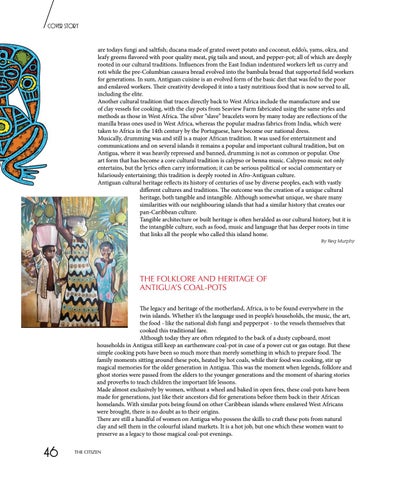cover story
are todays fungi and saltfish; ducana made of grated sweet potato and coconut, eddo’s, yams, okra, and leafy greens flavored with poor quality meat, pig tails and snout, and pepper-pot; all of which are deeply rooted in our cultural traditions. Influences from the East Indian indentured workers left us curry and roti while the pre-Columbian cassava bread evolved into the bambula bread that supported field workers for generations. In sum, Antiguan cuisine is an evolved form of the basic diet that was fed to the poor and enslaved workers. Their creativity developed it into a tasty nutritious food that is now served to all, including the elite. Another cultural tradition that traces directly back to West Africa include the manufacture and use of clay vessels for cooking, with the clay pots from Seaview Farm fabricated using the same styles and methods as those in West Africa. The silver “slave” bracelets worn by many today are reflections of the manilla brass ones used in West Africa, whereas the popular madras fabrics from India, which were taken to Africa in the 14th century by the Portuguese, have become our national dress. Musically, drumming was and still is a major African tradition. It was used for entertainment and communications and on several islands it remains a popular and important cultural tradition, but on Antigua, where it was heavily repressed and banned, drumming is not as common or popular. One art form that has become a core cultural tradition is calypso or benna music. Calypso music not only entertains, but the lyrics often carry information; it can be serious political or social commentary or hilariously entertaining; this tradition is deeply rooted in Afro-Antiguan culture. Antiguan cultural heritage reflects its history of centuries of use by diverse peoples, each with vastly different cultures and traditions. The outcome was the creation of a unique cultural heritage, both tangible and intangible. Although somewhat unique, we share many similarities with our neighbouring islands that had a similar history that creates our pan-Caribbean culture. Tangible architecture or built heritage is often heralded as our cultural history, but it is the intangible culture, such as food, music and language that has deeper roots in time that links all the people who called this island home.
By Reg Murphy
THE FOLKLORE AND HERITAGE OF ANTIGUA’S COAL-POTS The legacy and heritage of the motherland, Africa, is to be found everywhere in the twin islands. Whether it’s the language used in people’s households, the music, the art, the food - like the national dish fungi and pepperpot - to the vessels themselves that cooked this traditional fare. Although today they are often relegated to the back of a dusty cupboard, most households in Antigua still keep an earthenware coal-pot in case of a power cut or gas outage. But these simple cooking pots have been so much more than merely something in which to prepare food. The family moments sitting around these pots, heated by hot coals, while their food was cooking, stir up magical memories for the older generation in Antigua. This was the moment when legends, folklore and ghost stories were passed from the elders to the younger generations and the moment of sharing stories and proverbs to teach children the important life lessons. Made almost exclusively by women, without a wheel and baked in open fires, these coal-pots have been made for generations, just like their ancestors did for generations before them back in their African homelands. With similar pots being found on other Caribbean islands where enslaved West Africans were brought, there is no doubt as to their origins. There are still a handful of women on Antigua who possess the skills to craft these pots from natural clay and sell them in the colourful island markets. It is a hot job, but one which these women want to preserve as a legacy to those magical coal-pot evenings.
46
THE CITIZEN






















